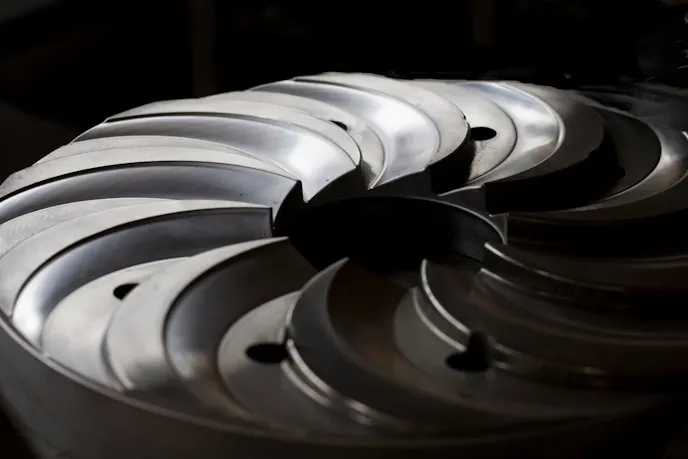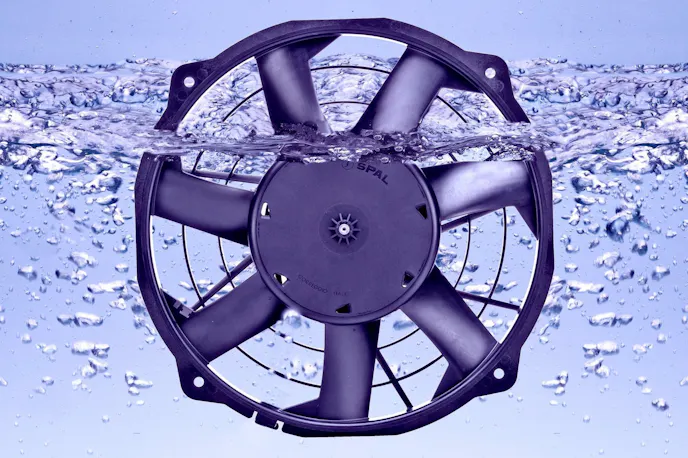As we roll through the hottest part of summer, we are reminded just how much a good cooling system matters — especially when it comes to a classic ride that you’ve spent so much of your time, money, and effort on. Whether you’re flogging a full-blown track animal or cruising a traditional hot rod, the wrong fan can turn your dream build into a heat-soaked headache. That’s why we asked the experts at SPAL USA to help us out with the questions every performance-minded enthusiast needs answered — what fan, why, and when? Here’s what they had to say.
Choosing A High-Performance Fan For Your Cooling System
How do I choose a fan that works well with a high-performance engine?
Choosing a fan that can handle high-performance engines requires considering several factors to ensure that it provides the proper airflow, cooling, and durability needed for intense operation. Here are the key issues to consider when selecting a fan for your high-performance build.
1. Airflow Capacity (CFM – Cubic Feet per Minute):
- Airflow: High airflow is crucial for a high-performance engine’s cooling system, as the engine generates more heat during operation. Look for fans that can move a higher volume of air (measured in CFM) to maintain optimal engine temperature.
- Engine size: Another factor to consider is the engine’s size, power, and the heat it generates. Larger or more powerful engines will require fans with higher CFM ratings.
2. Fan Size and Blade Design:
- Fan size: The physical size of the fan should match the engine’s cooling requirements. Larger fans, with larger diameter blades, generally move more air and are better for cooling larger or more powerful engines.
- Blade design: Look for fans with aerodynamic blades that can push air efficiently and create high static pressure, which is important for cooling under load and in tight spaces (e.g., radiators).

3. Fan Speed (RPM – Revolutions Per Minute):
- RPM: The fan speed is determined by the size of the fan and the power of the motor. When choosing a fan, airflow performance is the critical factor, not the RPM.
- Adjustable speed: Look for fans with adjustable speeds or fans that can automatically adjust to engine temperature to avoid unnecessary power consumption when the engine is running at low RPM.
4. Quality and Materials:
- Durability: A high-performance engine can put a lot of strain on a cooling system, so the fan needs to be durable. Opt for fans made from high-quality materials like reinforced plastics that can withstand high temperatures and vibrations.
- Longevity: Corrosion resistance is also key if the engine operates in environments with moisture, salt, or chemicals, like marine or off-road applications.
5. Motor Type:
- Brushless: Brushless motors are ideal for high-performance engines due to their efficiency, durability, and lower maintenance needs compared to brushed motors. The higher reliability of brushless motors makes them well-suited for demanding, high-heat environments.
- High-torque: High-torque motors may be necessary for fans in high-performance systems, as they can handle the increased load required to provide sufficient airflow at higher engine speeds.
6. Cooling Capacity:
- High-performance: Make sure the fan is rated for the thermal capacity required to handle high-performance engine cooling needs. Look for high-performance cooling fans designed for motorsport or industrial use, as they are optimized for handling intense heat generation.
7. Compatibility with Engine Type:
- What type of engine: Ensure the fan is compatible with the specific engine type (e.g., internal combustion, electric, turbocharged). For example, high-performance turbocharged engines may require more robust fans with greater airflow and pressure.
8. Voltage and Power Requirements:
- Electrical system: High-performance engines often require specific voltage and power levels for cooling. Make sure the fan is compatible with the electrical system of the engine, especially if it’s a custom or high-voltage setup.

9. Noise Levels:
- Decibels matter: High-performance fans can be noisy. Look for fans that balance high airflow and low noise, especially if the engine is in a closed or enclosed space.
- Technology matters: Some fans are designed with noise-reduction technology, such as variable pitch blades or special noise-damping materials.
10. Fan Control Options:
- Controllers: Consider intelligent fan controllers that adjust the fan speed according to the engine’s temperature. This ensures that the fan runs efficiently and doesn’t waste power or overcool the engine unnecessarily.
- Temp-based control: Features like thermostatic control can help the fan turn on only when needed, preventing excessive wear.
11. Environment and Application:
- Extreme conditions: If the engine operates in extreme conditions, like racing, off-roading, or marine environments, the fan should be designed to withstand those specific conditions (vibration, water, dirt, etc.).
- Weathering: Water-resistant or weatherproof designs are necessary for engines used outdoors, while fans with high airflow at low speed are often required for high-performance engines used in static or controlled environments.
In essence, choosing a fan for a high-performance engine requires the correct size, speed, blade design, and airflow capacity. Also, in addition to being compatible with your application, the fan’s construction and technology should be compatible with the environmental conditions it will be operating in.

What’s the difference between a puller fan and a pusher fan, and which one should I use?
Put simply, a puller fan “pulls” air through a radiator and is mounted behind the radiator, while a pusher fan “pushes” air through a radiator and is mounted in front of the radiator. Typically, a puller fan is recommended in most applications, provided there is enough space to properly mount a puller fan. Puller fans tend to be more efficient because they are pulling air through the radiator, which helps create a more consistent and direct airflow across the radiator. A puller fan also doesn’t obstruct any natural “through radiator” airflow like a front/pusher-style fan.
What are the benefits of using an electric fan compared to a mechanical fan for cooling?
The use of an electric fan versus a mechanical fan for cooling offers several key advantages, including:
- Improved efficiency
- Better cooling control
- Increased engine performance
- Space and mounting flexibility
- Reduced wear and tear on engine components
- Compatibility with your modern cooling system
Best Practices For Wiring And Installation
How do I wire the fan for optimal performance and reliability?
The first step is to ensure all connections are properly sized and fully seated together. In cases of vibration or corrosion, it can be common that a solid connection is lost between one or more components, leading to system failure or safety concerns. When choosing wire size to integrate an electrical fan into a vehicle, the wire should be adequately large enough to handle the worst-case electrical load expected to be running through it. When a new electrical connection needs to be joined, it is best practice to use commercially produced connectors to ensure the electrical connection’s reliability.
Should I use a thermostatic or manual switch to control the fan?
The decision on how to control the fan is impartial to the cooling system’s success within the vehicle. Typically, an automatic controller of some type is used to avoid the requirement of the driver remembering to activate the fan. That said, it is common practice in race-type applications to use a manual switch for fan activation.
What gauge wire and relays should I use to handle the fan’s power draw?
The wire gauge and relays should be sized to handle the worst-case electrical load expected. It is important to note that with DC electricity, as the length of the wire run increases, the size of the wire must be increased to handle the same amperage load. Many great tools exist online to help determine these values.
How do I properly ground the fan and prevent electrical issues?
The best recommendation for grounding the fan is to connect the ground wire from the fan directly to the negative terminal of the battery. This can often be complicated when customizing the design and build of a vehicle, either with the battery being an extended distance away from the fan or not having adequate room to route the wires. It is common for most vehicles to ground electrical devices through the main vehicle chassis, which in turn has a direct connection to the battery’s negative terminal.
What are the most common installation mistakes to avoid?
Here are a few common installation mistakes to keep in mind. When mounting the fan to the radiator, it is important to maintain some distance between the fan blades and the fins of the radiator. The fan blades flex a bit during operation as the force of the air acts on the fan blades. We recommend maintaining a minimum distance of 0.5 inches between the fan blades and the radiator face. It is important to seal the fan to the radiator and eliminate all possible air gaps between the fan and the radiator. If large gaps exist in this space, the fan will draw air from these gaps instead of forcing the air to flow through the radiator.
Cooling System Integration
Can an electric fan replace my stock mechanical fan without other modifications?
In most cases, an electric fan can be a direct replacement for matching the airflow previously provided by a mechanical fan. The most common exception to this guidance is understanding the power capability of the stock alternator. When using a mechanical fan, the fan blade is powered directly from the engine. When switching to an electric fan, the power is provided from the alternator, and it is important to make sure the alternator can supply the necessary power.
Should I upgrade my alternator or electrical system to run an electric fan?
Depending on what other modifications or components may exist on your vehicle, it may be necessary to upgrade the alternator.
How do I ensure the fan works with my thermostat and water pump?
The easiest way to test or verify the system’s functionality is a live experiment. When implementing the electric fan for the first time, it would be best to test the functionality by running the vehicle at idle in a parking lot or driveway before taking off on a road or interstate.
Proper Fan Placement And Airflow
How do I determine the best location for the fan on the radiator?
Determining the best location for an electric fan on the radiator depends on airflow efficiency, space constraints, and cooling system performance. Here are the key factors to consider:
Pusher vs. Puller Configuration
- A puller fan is typically more efficient because it pulls cooler outside air through the radiator.
- A puller fan does not block the incoming airflow when driving down the road, allowing the vehicle to utilize this “free” cooling.
- A puller fan creates a stronger airflow and maximizes the performance of your cooling system.
- If space allows, a puller fan is typically recommended for most applications.
- A pusher fan pushes air before it passes through the radiator, and can be less efficient because airflow can be limited by the radiator itself.
How much clearance is needed between the fan and other engine components?
It is critical to have some space between the fan blades and the radiator face. SPAL typically recommends about 0.5 inches as the minimum for that distance. Slight cooling improvements (a few percentage points) will likely be seen as this space is increased up to about three inches. Space is also needed on the backside of the fan, between the engine components and air flowing out of the fan, for the air to properly disperse away from the fan. As with the space between the radiator, 0.5 inches is about the minimum recommended distance, and slight cooling improvements can be seen as this space is increased out to a few inches.
At the end of the day, cooling isn’t just a convenience — it’s a necessity. Especially when you’ve poured your time, cash, and pride into a high-performance build. A cheap fan might save you a few bucks upfront, but it’ll cost you when the temp needle pegs and your investment goes up in steam. With this insight from the experts at SPAL USA, you now have the knowledge to make the right call on the street, at the strip, or anywhere in between.

You might also like
LT4 Swapped C10: A Square Body With A Mean Streak
An LT4-swapped C10 built with drag-race engineering, blending factory-clean style with 800 horsepower attitude.





